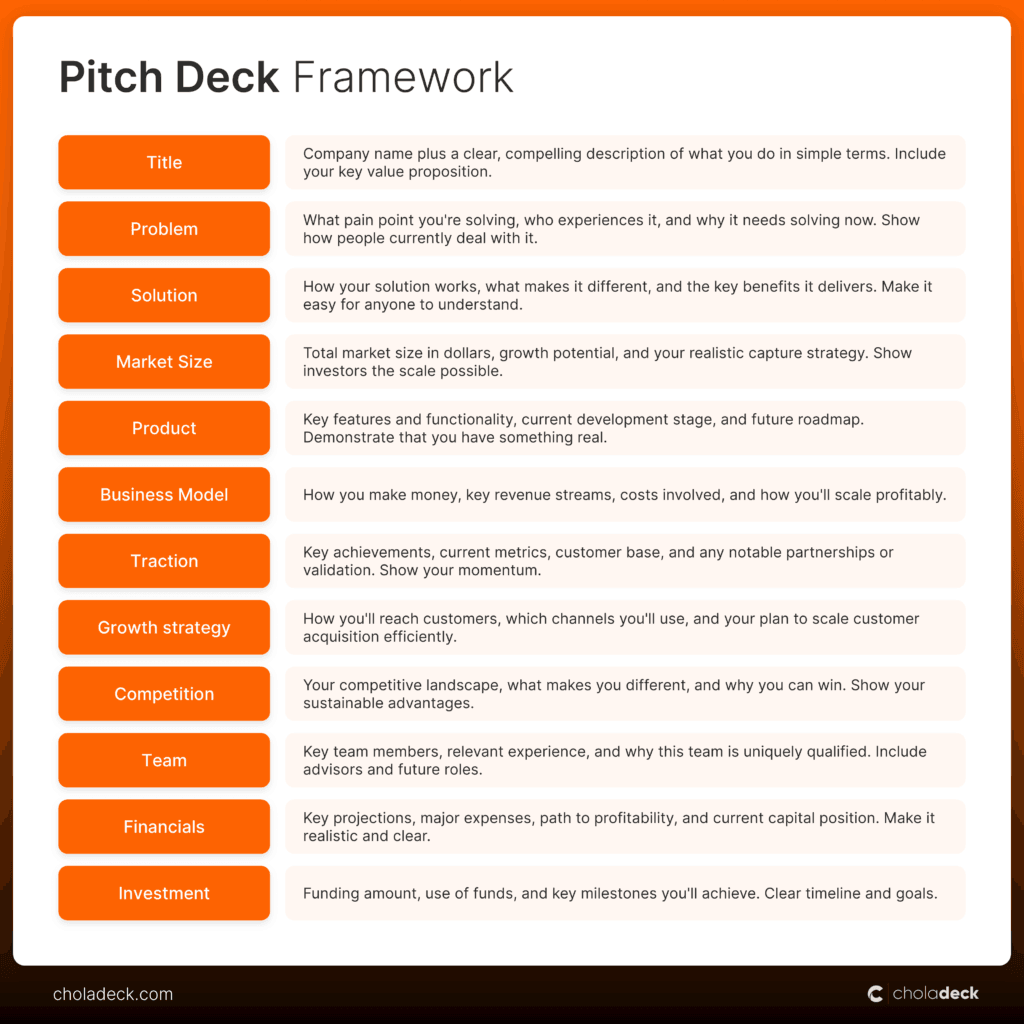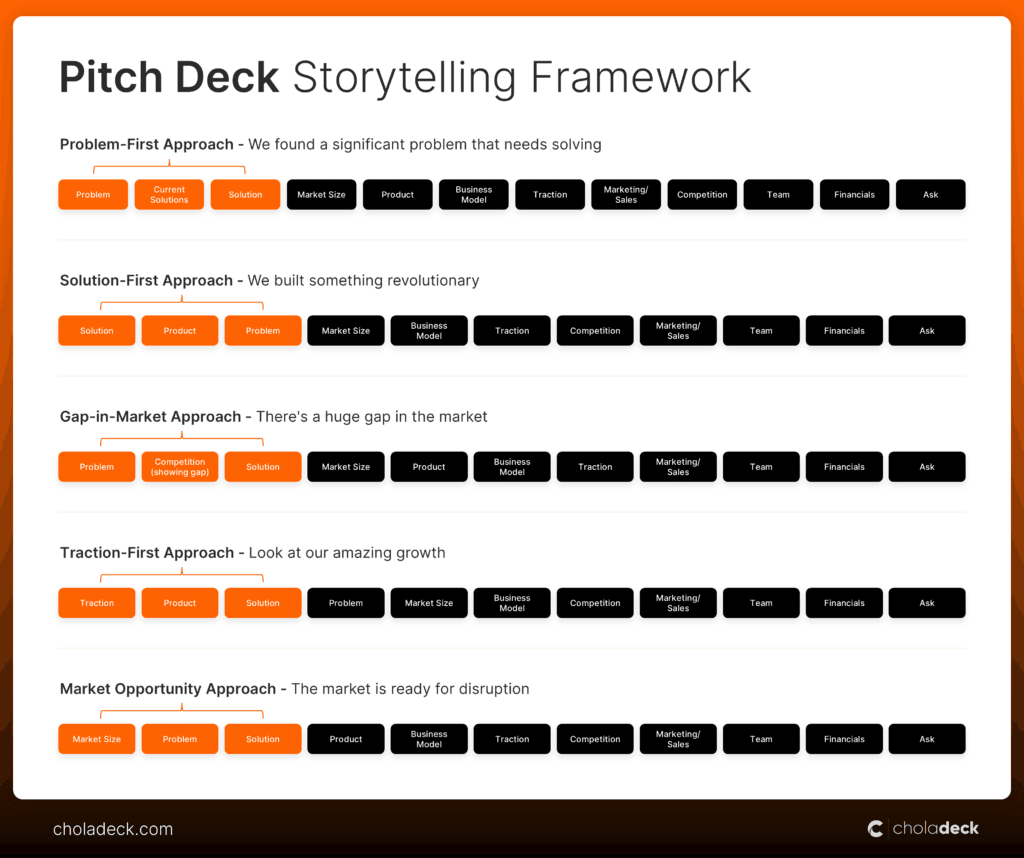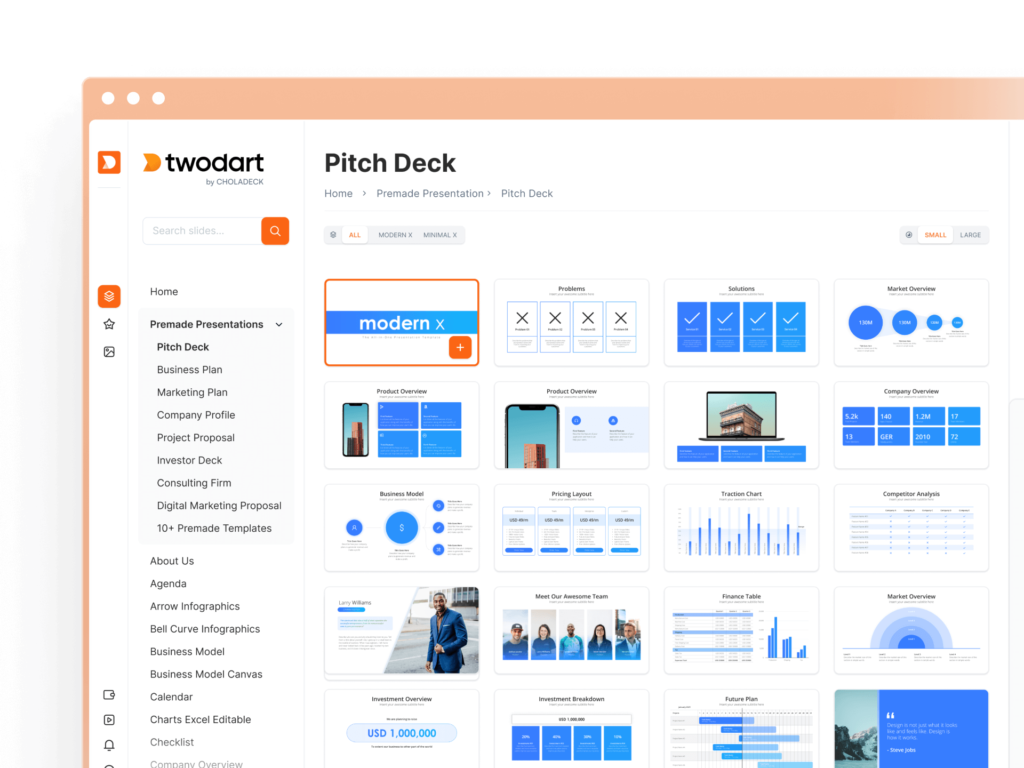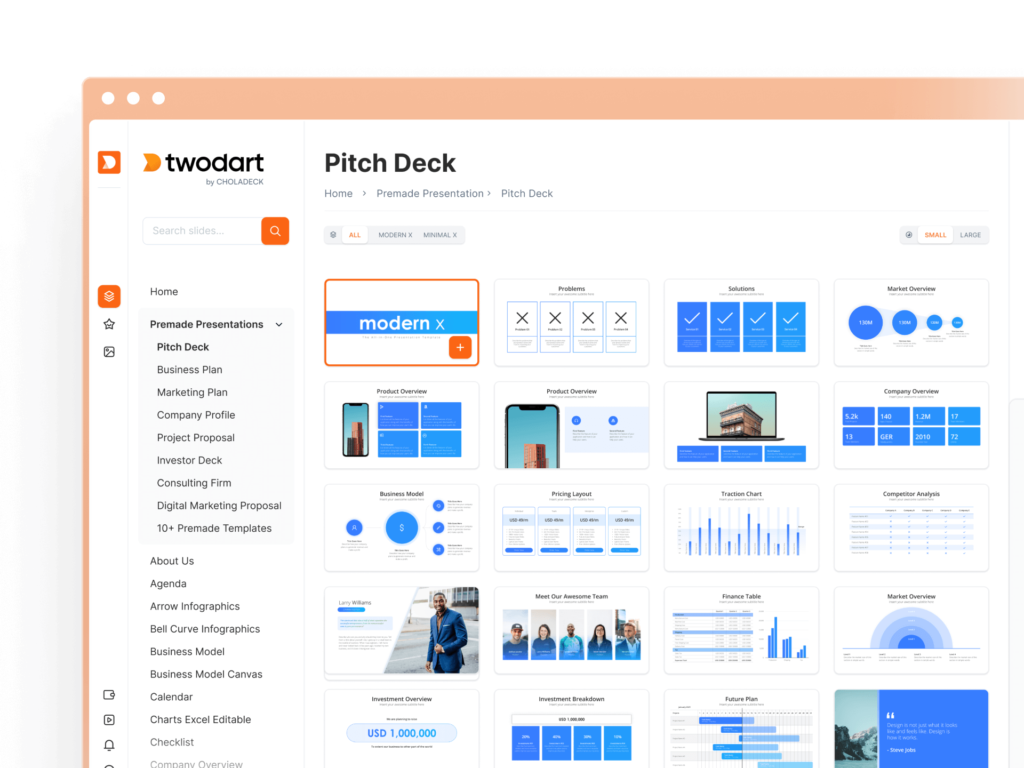In today’s competitive business landscape, having a compelling pitch deck with the right pitch deck structure is crucial for securing investment and support for your venture. Whether you’re a startup founder seeking funding or an entrepreneur presenting your business idea, understanding how to create an effective pitch deck and organize its structure can make the difference between success and missed opportunities. This comprehensive guide will walk you through the process of creating a powerful pitch deck that captures attention and drives results.
What is a Pitch Deck Presentation?
A pitch deck is a brief presentation that provides investors with an overview of your business, whether it’s a startup, an established company, or even a new product idea. Think of it as your business story told through a series of carefully crafted slides. This visual document outlines everything from your business model to financial projections, packaged in a way that’s both informative and engaging.
Your pitch deck presentation serves as a powerful visual aid that helps you:
- Present your business idea clearly and concisely
- Demonstrate the value of your solution
- Show the potential for growth and returns
- Establish credibility for your venture
Why Do You Need a Pitch Deck?
- Secure Funding – Present your business opportunity to investors clearly and effectively, demonstrating the potential for returns on their investment.
- Tell Your Story – Transform complex business ideas into a compelling narrative that resonates with your audience and showcases your vision.
- Save Time – Address key questions upfront and provide a comprehensive overview that can be shared and referenced easily.
- Build Credibility – Demonstrate professionalism and thorough preparation, showing you understand your market and business inside out.
This comprehensive presentation tool isn’t just for fundraising – it’s valuable for:
- Investor presentations
- Partner meetings
- Team alignment
- Sales presentations
- Strategic planning
How to Create a Pitch Deck
Creating an effective pitch deck requires more than just putting together a few slides. It’s about telling your story in a way that resonates with your audience and clearly communicates your business opportunity. Let’s break down the process, starting with understanding the essential structure every successful pitch deck presentation needs.
Understanding Pitch Deck Structure
Before you start designing slides or writing content, it’s crucial to understand the fundamental structure of a pitch deck. If you understand this everything else becomes really easy.
Here’s the most comprehensive and easy-to-understand breakdown of each component your pitch deck should include:
1. Title Slide – This is your first impression. It’s not just about your company name – it’s your chance to grab attention and give investors a clear picture of what your business does.
- What’s your company name?
- What do you do, in the simplest terms? (Think 5-7 words that anyone can understand)
- What’s your tagline or value proposition that instantly communicates your benefit?
- Who are the presenters and their roles?
2. Problem – This is where you help investors understand why your business needs to exist. Think of it as setting the stage – if there’s no real problem, there’s no need for a solution. Paint a clear picture of the pain point or challenge that your target customers are facing.
- What specific problem or challenge are you solving?
- Who is experiencing this problem? (Be specific about your target audience)
- Why is this problem significant enough that people will pay for a solution?
- How are people dealing with this problem today?
3. Solution – Now that you’ve established the problem, show how your product or service solves it. This is your opportunity to get investors excited about your solution and help them understand why it’s special.
- How exactly does your solution solve the problem?
- What makes your approach different from current solutions?
- What are the main benefits for your customers?
- Can you explain your solution in a way that anyone can understand?
4. Market Opportunity – Here’s where you show investors the potential size of your business. Help them understand that there’s a large enough market to build a significant company. Remember, investors are looking for big opportunities.
- How many people or businesses face the problem you’re solving?
- What’s the total money spent in your market annually? (Market size in dollars)
- How much of this market can you realistically capture?
- Is your market growing? At what rate?
5. Product/Service – Dive deeper into what you’ve built or are building. Show investors that you have something real and tangible, not just an idea. This is your chance to showcase the actual solution in action.
- What are the key features of your product/service?
- How does it work? (Keep it simple and visual)
- What stage are you at? (Prototype, beta, launched, etc.)
- What’s your development roadmap?
- Do you have any intellectual property or patents?
6. Business Model – Explain how you make money in simple terms. Investors need to understand that you have a clear path to generating revenue and eventually becoming profitable.
- How do you charge for your product/service?
- What are your revenue streams?
- What are your costs to deliver your solution?
- What are your margins?
- Is your model scalable?
7. Traction – Show evidence that your solution works and people want it. This is where you prove that you’re not just talking – you’re executing and gaining momentum.
- What have you achieved so far? (Key milestones)
- Do you have any customers? Who are they?
- What are your key growth metrics?
- Do you have any partnerships or relationships worth mentioning?
- What validation can you show? (Awards, press, partnerships)
8. Marketing & Sales Strategy – Demonstrate that you have a solid plan to reach your customers and grow your business. Show investors you understand how to take your solution to market effectively.
- How will you reach your target customers?
- What marketing channels will you use?
- What’s your sales process?
- How much does it cost to acquire a customer?
- How will you scale your customer base?
9. Competition – Show that you understand your market and competitive landscape. This proves you’re realistic and have thought about how to win in your market.
- Who are your direct and indirect competitors?
- What makes you different from alternatives?
- Why can you win against competitors?
- What are your sustainable competitive advantages?
- What barriers to entry do you have?
10. Team – Build confidence in your ability to execute. Investors often say they invest in people first, so show why your team is the right one to build this business.
- Who are the key team members?
- What relevant experience does each person bring?
- Why is this team uniquely qualified to succeed?
- What key roles do you need to fill?
- Who are your advisors or board members?
11. Financial Overview – Show the potential financial outcome of your business. Help investors understand the investment opportunity and how their money will help you grow.
- What are your revenue projections for the next 3-5 years?
- What are your key expenses?
- When do you expect to become profitable?
- What are your key financial metrics?
- How much capital have you raised so far?
12. The Ask – Clearly state what you’re looking for from investors. Be specific about how much money you need and how you’ll use it to grow your business.
- How much money are you raising?
- How will you use the funds?
- What major milestones will you achieve with this funding?
- What’s your timeline for achieving these milestones?
- What’s your planned exit strategy?
Pro Tip: Think of your pitch deck structure like building blocks – each component builds upon the previous one. Each slide should naturally lead to the next, creating a foundation that helps investors understand your complete business story. For example, understanding the problem helps explain why your solution matters, which then helps justify the market opportunity, and so on.
Writing Your Pitch Deck Content
Now that you understand the framework, let’s focus on writing compelling content. Here’s an exercise to help you develop your core message:
Fill in the blanks to craft your story:
[Company name] helps [specific target audience] who struggle with [specific problem/pain point]. We solve this by providing [your solution], which [explain how it works in simple terms]. Unlike [current alternatives], we [key differentiator] which results in [main benefit]. Our solution addresses a [market size] market, and we've already [key traction/achievements]. We make money through [business model], and we're seeking [amount] to [key milestones].
This simple exercise helps you identify your core message. Once you have this foundation, expand each section using our framework questions as your guide to develop your content further.
Pro Tip: Keep your message clear and concise. Use data to support your claims, focus on benefits over features, and avoid industry jargon. Your story should be compelling enough for anyone to understand.
Crafting Your Story and Structure
Your pitch deck structure should tell a compelling story. This means your presentation should flow naturally from one point to the next, helping your audience follow your business journey and understand your opportunity clearly.
- Problem-First Approach – This structure works by building up the problem’s significance before revealing your solution and its market potential. “We discovered this big problem, here’s how we’re solving it, and here’s why it’s a huge opportunity.”
Best for: When the problem is very relatable and compelling enough to hook investors immediately. - Solution-First Approach – This approach showcases your innovative solution before diving into the problem it addresses. “We’ve created something amazing, here’s the important problem it solves, and here’s why it’s going to be huge in the market.”
Best for: When your solution is truly innovative or revolutionary and can grab attention instantly. - Gap-in-Market Approach – This structure emphasizes the market gap and positions your solution as the answer everyone’s been waiting for. “We found this major problem, surprisingly no good solutions exist in the market, and here’s our unique approach to solving it.”
Best for: When you’ve identified an underserved market with clear evidence of lack of solutions. - Traction-First Approach – This structure leads with your impressive metrics and momentum before explaining the business details. “Look at our amazing growth, here’s what we’re doing, and here’s why we’ll grow even bigger. “
Best for: When you have strong growth numbers and market validation to showcase. - Market Opportunity Approach – This approach highlights market trends and timing before revealing how your solution fits perfectly. “Here’s this massive changing market, why now is the perfect time, and how we’re positioned to capture it.”
Best for: When market timing and size are your strongest selling points.
Pro Tip: While these structures provide different approaches, choose the one that leads with your strongest asset – whether it’s a compelling problem, innovative solution, impressive traction, or perfect market timing. The key is to hook your audience early.
Designing Your Pitch Deck Presentation
Once you have your content and structure ready, it’s time to transform it into a visually engaging pitch deck PowerPoint presentation. Here’s how to create slides that communicate your message effectively:
- Professional Design Principles – Keep these fundamentals in mind:
- Consistent layout and alignment
- Plenty of white space
- Text should be readable from a distance (minimum 20pt font)
- Maximum 3-4 colors in your palette
- Stick to 1-2 font families
- Visual Hierarchy – Guide your audience’s attention:
- Clear, compelling headlines
- Important information larger and bolder
- Supporting details in smaller text
- Use contrast to highlight key points
- Keep bullet points brief (3-5 per slide)
- Data Visualization – Make your numbers tell a story:
- Transform text-heavy data into charts
- Choose the right chart type for your data
- Keep graphs simple and clear
- Label data points clearly
- Use colors consistently in all charts
Pro Tip: Strong design doesn’t mean fancy animations or complex graphics. Focus on clarity and professionalism. Your slides should enhance your story, not distract from it. When in doubt, simpler is better.
Creating a professional pitch deck presentation requires careful attention to content, structure, and design. Throughout this guide, we’ve covered the essential elements needed to create a compelling pitch deck – from understanding the fundamental structure and crafting your content, to organizing your story and designing impactful slides.
Remember, a successful pitch deck isn’t just about having great content or stunning design – it’s about bringing all these elements together cohesively. Your structure should support your story, your design should enhance your content, and everything should work together to communicate your business opportunity clearly and convincingly.
By following these principles and guidelines, you’ll be able to create slides that effectively communicate your business story and engage your audience. Whether you’re pitching to investors, presenting to partners, or aligning your team, these fundamentals will help you craft a presentation that achieves your goals.
However, if you want to save time and ensure you build an amazing pitch deck, we’ve got you covered.
Build Professional and Clear Pitch Deck Presentations with Choladeck
Our pitch deck PowerPoint template is designed to help you create impactful presentations quickly and effectively:
- Professional Design
Built following the design principles above, our template ensures your pitch deck looks polished and professional from the start. - Consistent Branding
Easily customize colors, fonts, and logos to match your brand identity while maintaining visual consistency throughout your presentation. - Data Visualization
Choose from our variety of pre-designed charts, graphs, and diagrams to present your data clearly and impactfully. - Comprehensive Resource Library
Access our curated collection of business icons, images, and graphics to enhance your presentation’s visual appeal effectively.
Our template doesn’t just help you create a visually stunning presentation – it guides you through the entire pitch deck structure we discussed above. By combining professional design, intuitive structure, and flexible customization options, our template empowers you to create a compelling pitch deck that gets results.
Ready to create your pitch deck?
Try our professional PowerPoint template absolutely free by registering here.






